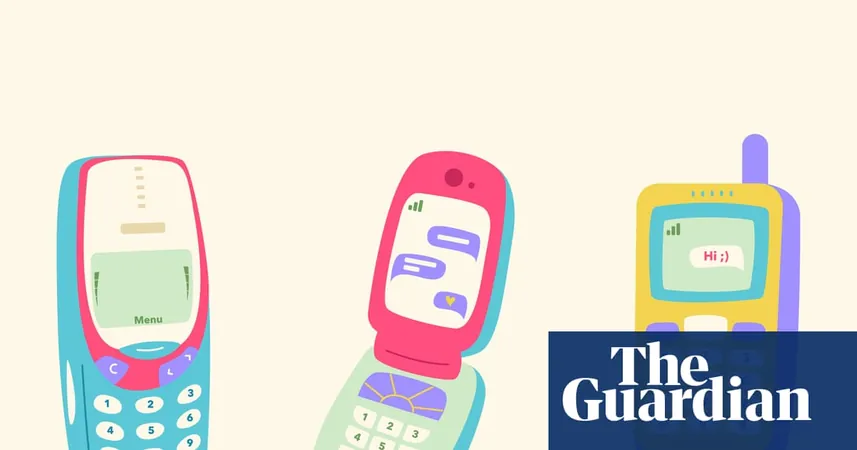
The Great Kid Phone Debate: How Parents Can Guide the First Smartphone Experience
2025-09-22
Author: Wei
The Evolving Landscape of Children's Mobile Phones
Two decades ago, Australian kids clamored for their first mobile phones, with the iconic Motorola Razr in pink or silver becoming a status symbol. Playing Snake on those primitive Nokia screens was the ultimate childhood experience. Fast forward to today, and the decision to give a child their first phone has transformed into a minefield for parents.
Navigating the Phone Dilemma
As smartphones continue to impact mental health—affecting self-esteem and sleep patterns—parents are overwhelmed by options. Should they opt for a retro 'dumb' phone reminiscent of the early 2000s or venture into the world of smartphones? And if they go the smartphone route, how can they control their child's usage?
What's Trending for Young Users?
Retail experts like Stephanie Wardill from Officeworks note a significant spike in sales of 'low-tech phones'—up 1.5 times this past year. Various quasi-smartphones, like the Opel Mobile Smartkids and G-Mee, offer middle-ground solutions for cautious parents.
The Heads Up Alliance also promotes retro devices such as the Nokia 3210 and Opel Mobile Flip Phone. These classics have limited internet functionality, with some entirely free from social media access. The innovative Light Phone provides basic features alongside parental control options through a secure dashboard.
Smartwatches: A Rising Alternative
Many parents are gravitating towards smartwatches instead of traditional phones. The Spacetalk Adventurer 2 allows kids to make video calls and texts while providing GPS tracking, without full internet access.
Cue the Parental Controls
Devices like the new HMD Fuse smartphone boast built-in parental controls and a unique feature: HarmBlock+, which scans for inappropriate images—a subscription service designed to keep children safe online.
Expert Opinions: To Monitor or Not?
While some devices allow for extensive monitoring, experts have differing opinions on such surveillance. Many advocate for open conversations with kids about responsible phone use instead of strict oversight. Prof. Ian Hickie suggests phones are like modern cigarettes, but with both pros and cons. The key is engaging with teens about internet safety and setting boundaries.
Recognizing the Psychological Impact
Clinical psychologist Dr. Simon Wilksch emphasizes the mental health risks tied to smartphones, particularly the effects of front-facing cameras on body image issues. He advises delaying smartphone ownership to reduce psychological distress.
Establishing Healthy Boundaries
Experts urge parents to model responsible behavior. Dr. Ariana Hoet suggests being transparent about rules and expectations surrounding phone use.
The Importance of Active Involvement
Researcher Dr. Joanne Orlando highlights that children typically receive their first smartphone at ages 11 or 12, pressured by peers. She stresses the importance of parents being engaged during this initial stage, discussing features and expectations rather than relinquishing control too soon.
Conclusion: A Balancing Act
As parents consider what device to gift their child, the consensus is clear: active involvement in their first smartphone experience is crucial. Navigating the complexities of technology with open communication and clear guidelines will empower kids to use their devices responsibly, ensuring a safe and healthy digital journey.




 Brasil (PT)
Brasil (PT)
 Canada (EN)
Canada (EN)
 Chile (ES)
Chile (ES)
 Česko (CS)
Česko (CS)
 대한민국 (KO)
대한민국 (KO)
 España (ES)
España (ES)
 France (FR)
France (FR)
 Hong Kong (EN)
Hong Kong (EN)
 Italia (IT)
Italia (IT)
 日本 (JA)
日本 (JA)
 Magyarország (HU)
Magyarország (HU)
 Norge (NO)
Norge (NO)
 Polska (PL)
Polska (PL)
 Schweiz (DE)
Schweiz (DE)
 Singapore (EN)
Singapore (EN)
 Sverige (SV)
Sverige (SV)
 Suomi (FI)
Suomi (FI)
 Türkiye (TR)
Türkiye (TR)
 الإمارات العربية المتحدة (AR)
الإمارات العربية المتحدة (AR)